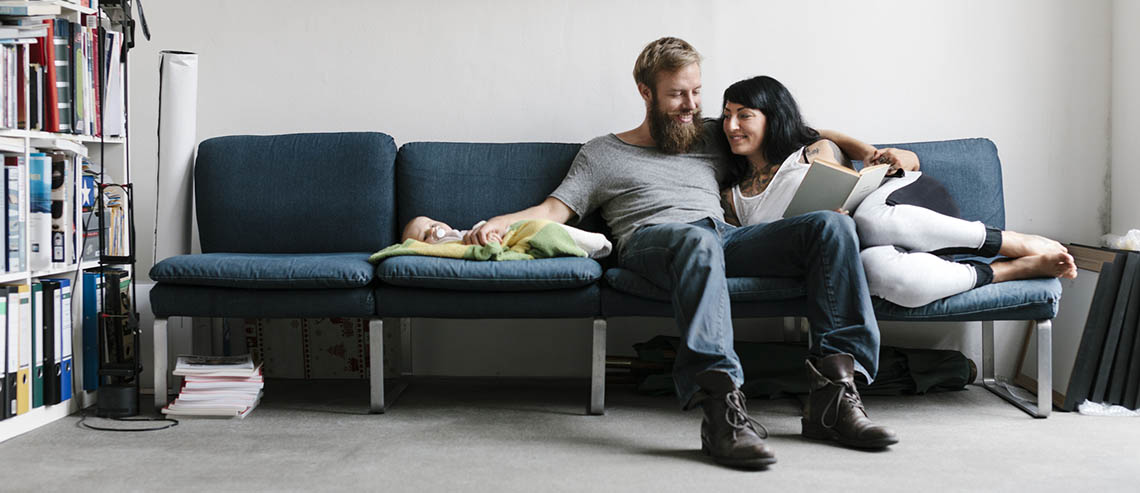
Earn cash back
after close!
With Home Connect, you could earn $350 to $9,500 cash back after close.
Buying a home is one of life’s most rewarding milestones. However, as a prospective homebuyer, you may have noticed how much the real estate landscape has changed over the past few years.
Let’s take a look at how a temporary mortgage buydown concession could reduce your interest rate and make your initial monthly payments more affordable.
What Is a Temporary Buydown on a Mortgage?
A temporary buydown is a mortgage financing strategy that allows a homebuyer to lower their interest rate and payment for a predetermined amount of time through the payment of mortgage points at closing (whether by the lender, homebuyer or seller).
What’s a mortgage point? A mortgage point, also known as a mortgage discount point, equals 1% of your total loan amount. For example, a mortgage point on a $200,000 loan would be $2,000. When you purchase points in a mortgage buydown, you’re essentially prepaying interest upfront at closing in exchange for a lower rate, i.e., “buying it down.” Typically, a lender may offer a .25% rate reduction in exchange for one point.
How long could the rate and payment reduction last? Up to three years.
How much could the rate be reduced? A maximum of 3%. The rate is lower in the introductory period and increases over time — a maximum increase of 1% per year — to the original quoted rate.
What happens to those mortgage point payments? The money will typically go into an escrow account. Those funds temporarily subsidize your interest rate for the agreed-upon time period.
According to Scott Bridges, senior managing director of Pennymac’s consumer direct lending division, the benefit of a buydown is simple. “In short, the buydown allows a buyer to combat higher market rates,” he explains. “The first year of the loan, your rate and payment will be based on a rate that is 1% lower than the market rate. So if current rates are 6%, your first year of payments would be based on a 5% rate. That reduced rate for year one can save the average consumer several thousand dollars in payments (depending on loan amount).”
While interest rate discounts, loan terms, and conditions vary by lender, a buydown can be a good option for temporarily lowering your monthly mortgage payments at the start of your loan.
What Are the Benefits of Buying Down an Interest Rate?
There are several reasons you may want to buy down your mortgage rate. Here are a few potential budget-friendly benefits:
- Lowers initial monthly mortgage payments. If you have a temporary buydown, those points you pay for upfront can make your initial mortgage payments more manageable, which can be especially helpful if you’re at the beginning of your career and expect your income to rise in the future. Those early savings will also add up to less interest paid over the life of your loan.
- Can be arranged for both purchases and limited cash-out refinances. Whether you’re buying a new home or doing a limited cash-out refinance and replacing your current mortgage with a new, slightly larger mortgage, you may qualify for a temporary interest rate buydown.
- Potential tax write-off. While a seller, builder, or lender may cover the buydown to facilitate a sale, the points may be deductible as home mortgage interest if you’re the buyer and pay for the buydown.1
- Reduces rates for fixed-rate and adjustable-rate mortgages (ARM). You can purchase points to lower your interest rate on a fixed-rate mortgage and during an ARM’s introductory fixed-rate period. Depending on the buydown structure, rates may be reduced up to 3% for a maximum of three years.
- More money in your pocket. A lower mortgage payment at the start of your loan could free up cash to pay bills or make home improvements.
- Allows you to watch the market. A buydown gives you an opportunity to watch the market while saving on your monthly payments. “As rates move up and down during and after that first year, you can refinance into a lower rate with the knowledge you had a full year of reduced mortgage payments,” Bridges notes.
How Much Does It Cost to Buy Down the Interest Rate?
Generally speaking, the approximate cost for a temporary mortgage buydown equals how much you'll ultimately save in interest. But several factors will be taken into account:
- How much money you’re borrowing
- How many points you’re buying; each point costs 1% of the mortgage amount
- Type of buydown structure
Who funds a temporary mortgage buydown? In most cases, the buyer will pay the mortgage points, but in some instances, the buydown could be fully or partially funded by the seller, lender, or third party, such as a realtor or builder.
How long will the reduced interest rate be in effect? The lower rate and payment will be in effect for up to three years, depending on the rate buydown structure. Below are a few different types of mortgage buydowns.
Rate Buydown Structures
There are several types of rate buydown structures. If your lender offers you a buydown — most, but not all, lenders do — you will have the opportunity to negotiate pricing and determine which structure suits your financial needs. The following are the most common types of temporary mortgage buydown structures.
3-2-1 Buydown
A 3-2-1 buydown is a home financing arrangement that will reduce a homebuyer’s interest rate for the initial three years. The lowest interest rate is in the first year, increasing to the permanent quoted rate after the third year.
3-2-1 Buydown Basics
- Reduces rate by three percentage points in the first year of the mortgage
- Reduces rate by two percentage points in the second year
- Reduces rate by one percentage point in the third year
- Borrower pays full interest rate after the completion of the third year and is fixed for the remainder of the loan
3-2-1 Buydown Example
This chart shows how a 3-2-1 rate buydown could potentially work if you were to qualify for a 30-year, $200,000 mortgage at a rate of 7%:
| Mortgage Year | Interest Rate | Monthly Payment (Principal and Interest) | Monthly Savings | Annual Savings |
|---|---|---|---|---|
| 1 | 4% | $954.83 | $375.77 | $4,509.24 |
| 2 | 5% | $1,073.64 | $256.96 | $3,083.52 |
| 3 | 6% | $1,199.10 | $131.50 | $1,578 |
| 4 – 30 | 7% | $1,330.60 | $0 | $0 |
In this scenario, the total buydown cost would be approximately $9,171, the amount equal to the first three years of interest savings. The chart amounts don’t include insurance or taxes, and you will want to assume no points contribution from the seller, builder, lender, or a third party.
2-1 Buydown
A 2-1 buydown is a type of home financing arrangement that reduces the interest rate on a mortgage for the first two years, after which the rate rises to the permanent quoted rate.
2-1 Buydown Basics
- Reduces rate by two percentage points in the first year of the mortgage
- Reduces rate by one percentage point in the second year
- Borrower pays full interest rate after the completion of the third year for the remainder of the loan
2-1 Buydown Example
This chart shows how a 2-1 rate buydown could potentially work if you were to qualify for a 30-year, $200,000 mortgage at a rate of 7%:
| Mortgage Year | Interest Rate | Monthly Payment (Principal and Interest) | Monthly Savings | Annual Savings |
|---|---|---|---|---|
| 1 | 5% | $1,073.64 | $256.96 | $3,083.52 |
| 2 | 6% | $1,199.10 | $131.50 | $1,578 |
| 3 – 30 | 7% | $1,330.60 | $0 | $0 |
In this scenario, the total cost of the buydown would be approximately $4,661.52, the amount equal to the first two years of interest savings. The chart amounts don’t include insurance or taxes, and assume no points contribution from the seller, builder, lender, or a third party.
1-0 Buydown
A 1-0 buydown is a type of home financing arrangement that reduces the mortgage interest rate by 1% in the first year, increasing to the permanent quoted rate after that initial year.
1-0 Buydown Basics
- Reduces rate by one percentage point in the first year of the mortgage
- Borrower pays full interest rate after the completion of the first year for the remainder of the loan
1-0 Buydown Example
This chart shows how a 1-0 rate buydown could potentially work if you were to qualify for a 30-year $200,000 mortgage at a rate of 7%:
| Mortgage Year | Interest Rate | Monthly Payment (Principal and Interest) | Monthly Savings | Annual Savings |
|---|---|---|---|---|
| 1 | 6% | $1,199.10 | $131.50 | $1,578.00 |
| 2 – 30 | 7% | $1,330.60 | $0 | $0 |
In this scenario, the total cost of the buydown would be approximately $1,578, the amount equal to the first year of interest savings. The chart amounts don’t include insurance or taxes and assume no points contribution from the seller, builder, lender, or a third party.
Who Can Buy Down a Mortgage?
In most cases, the buyer will buy down the mortgage, but there are times when the seller, builder, or lender will offer to purchase points and pay for the buyer’s mortgage buydown. Let’s take a look at each scenario.
Buyer-Funded Buydown
When a buyer negotiates a buydown with a lender, they pay a certain amount of points upfront at closing in exchange for a reduced interest rate. Depending on the buydown structure, the rate could be temporarily lowered for up to three years or the entire loan term. Most mortgage buydowns are buyer-lender arrangements.
Seller-Funded Buydown
A seller-funded buydown is when a highly motivated seller purchases points and buys down the homebuyer’s interest rate. This seller concession can help “seal a deal” by incentivizing and speeding up a home sale. Subsidizing a mortgage buydown can:
- Give a seller a competitive advantage without having to lower the listing price
- Help increase the borrower’s purchasing power
- Make it easier for buyers to qualify for financing
- Expedite the home sale process
A possible win-win for both the seller and the buyer. The seller could make a faster sale while holding on to more profits than they would if they lowered the asking price. The buyer saves money with a lower interest rate.
Builder-Funded Buydown
Homebuilders can offer mortgage buydowns to attract prospective homebuyers. As interest rates climb and the new-home market slows, builder buydowns are becoming an increasingly popular selling strategy. A recent survey found that 75% of nationally surveyed home builders confirmed they are buying down buyers’ mortgage rates to make payments more affordable.2 Builder buydowns can:
- Lure buyers in a competitive and high mortgage market
- Make new homes more affordable to a broader range of buyers
- Be offered as part of a package, such as an upgrade or closing cost contribution
A builder buydown arrangement may require the buyer to go through the builder’s mortgage company for the mortgage.
Lender-Funded Buydown
Lenders may offer to subsidize a buydown by contributing all or some of the funds for the mortgage points. This concession option could help increase your negotiating and purchasing power as a borrower.
Is Buying Down an Interest Rate Right for You?
A temporary lower interest rate is certainly enticing, but mortgage buydowns aren't for everyone. Buying mortgage points in exchange for a rate reduction may not be in your best interest if you are…
- Having trouble meeting loan qualification criteria: You must qualify for the standard loan terms without the benefit of the buydown. This also includes:
- Having a minimum 660 FICO score
- Meeting the applicable Fannie Mae requirements
- Submitting mandatory documentation
- Purchasing an investment property or manufactured home: A mortgage buydown can be arranged for a principal, owner-occupied home, or a second home. It’s not available for investment properties or manufactured homes.
- Planning on selling soon: There are substantial upfront costs involved with buying a new home, including the down payment and closing costs. Add mortgage points to the mix and it will take time to “break even,” meaning the time it will take for your savings to outweigh those costs to lower your interest rate. If you sell in the near future, you may not have been in the home long enough to recoup those point costs.
- Doing a regular cash-out refinance: Mortgage buydowns are allowed on purchases and limited cash-out refinances only. Limited cash-out refinances follow Fannie Mae guidelines restricting the cash-back amount to $2,000 or 2% of the new loan principal balance, whichever is less.3
- Short on cash: If you have limited cash, the high upfront costs may deplete your savings, leaving you short on funds you may need to cover other future expenses. Instead of buying points, you may want to allocate those funds to paying down high-interest debt or building an emergency fund.
- Making a small down payment: If you’re purchasing a home and contributing less than 20% to the down payment, or if you’re refinancing and have less than 20% equity, you’ll likely have to pay for private mortgage insurance (PMI) on your conventional loan.4 The premium will be added to your regular monthly payment. Rather than pay for points, consider using that money to make a larger down payment.
When can a mortgage buydown make sense? This home loan strategy is worth exploring if…
- You have enough liquid cash: If your savings is enough to cover the down payment, closing costs, and mortgage points — and you have a cash reserve left over — a temporary mortgage buydown can be a great option for reducing your interest rate for up to three years.
- You expect your income to rise: Starting your career? Re-entering the workforce? If you anticipate that your income will rise within the next few years, a temporary mortgage buydown can help you ease into homeownership with a lower initial interest rate and payment.
- The seller, builder, or lender is paying for the points: If you’re a homebuyer and the seller, builder, or lender offers to purchase the mortgage points for you, a temporary buydown can be an easy way to save money without any point-related, out-of-pocket expenses.
“Lots of people avoid buying a home when rates are higher,” says Bridges, "but this program allows you to at least achieve some reduced payments and real savings for a year.”
Higher rates can also significantly slow down home buying demand. That means, Bridges adds, “You will likely pay less for the house than you would in a low rate market when multiple buyers tend to bid over asking.” With a buydown, you set yourself up to win on multiple fronts. “You get a deal on the house you want, save money on the purchase price of the home in this higher rate market, save money on the monthly payment in year one, and refinance when rates drop.”
The Permanent Mortgage Rate Buydown Option
Want to lower your interest rate and monthly mortgage payment for your entire loan term? In addition to a temporary buydown, you may be eligible to negotiate a permanent buydown with your lender.
- Protects against rate hikes. The lower rate will never increase during the loan term as long as you have a fixed-rate mortgage.
- How much does it cost? The rate typically costs between six and eight points. Costs are added to the closing fees.
Ready to learn more about how Pennymac can help you find the right home loan? Begin your online application now, and if you still have questions, contact a Pennymac Loan Expert. We’ll help you evaluate your mortgage buydown options and decide the best course of action for your unique situation.
1 https://www.irs.gov/taxtopics/tc504
2 https://www.realestateconsulting.com/the-light-rate-buydowns-help-buyers-purchase-new-homes/
3 https://selling-guide.fanniemae.com/sel/b2-1.3-02/limited-cash-out-refinance-transactions
4 https://www.consumerfinance.gov/ask-cfpb/what-is-private-mortgage-insurance-en-122/
Share
Categories





